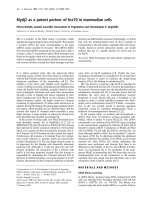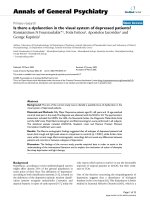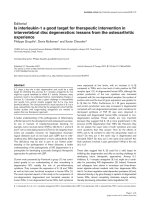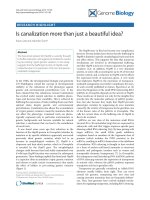Báo cáo y học: " Is eosinopenia a reliable marker of sepsis" pps
Bạn đang xem bản rút gọn của tài liệu. Xem và tải ngay bản đầy đủ của tài liệu tại đây (39.99 KB, 2 trang )
Available online />Page 1 of 2
(page number not for citation purposes)
We have read with interest the article by Abidi and
colleagues [1] in which the authors point out that eosinopenia
could be useful to differentiate between noninfection and
infection in patients recently admitted to an intensive care unit
(ICU). The association of eosinopenia with infections is not
new and has been described previously [2].
To test this hypothesis, we reviewed 191 patients (age
>18 years, with a minimum ICU stay of 24 hours) admitted to
the medical ICU of our hospital. We exuded HIV-infected
patients and those with hematological malignancies. Total
leukocyte and eosinophil count (EC) were measured at ICU
admission. The results are shown in Table 1. Although the EC
was lower and the proportion of patients with eosinopenia
(<40 cells/ml) was higher in the noninfectious systemic
inflammatory response syndrome (SIRS) group compared
with the infectious SIRS group, these differences were not
statistically significant. Therefore, the EC was not useful to
Letter
Is eosinopenia a reliable marker of sepsis?
Alex Smithson
1
, Rafael Perelló
2
and Josep-Maria Nicolas
3
1
Infectious Diseases Unit, Hospital Clínic, IDIBAPS, University of Barcelona, 08036 Barcelona, Spain
2
Emergency Department, Hospital Clínic, IDIBAPS, University of Barcelona, 08036 Barcelona, Spain
3
Medical Intensive Care Unit, Hospital Clínic, IDIBAPS, University of Barcelona, 08036 Barcelona, Spain
Corresponding author: Alex Smithson,
Published: 1 June 2009 Critical Care 2009, 13:409 (doi:10.1186/cc7877)
This article is online at />© 2009 BioMed Central Ltd
See related research by Abidi et al., />EC = eosinophil count; ICU = intensive care unit; SIRS = systemic inflammatory response syndrome.
Table 1
Baseline characteristics of the ICU patients included in the study
Infectious SIRS (n = 142) Noninfectious SIRS (n = 49) P-value*
Age (years) 62.7 ± 15.3 66.8 ± 14.3 0.1
APACHE II score 16.6 ± 6.5 17.8± 6 0.27
SAPS II score 36.6 ± 12.1 36.4 ± 11.4 0.95
SOFA score 8.8 ± 3.2 7.7 ± 2.7 0.034
Length of ICU stay (days) 11.4 ± 11.3 7.5 ± 7.8 0.03
Sites of infection
Community-acquired pneumonia 57 (40.1%) NA
Hospital-acquired pneumonia 9 (6.3%) NA
Urinary tract infection 11 (7.7%) NA
Bacterial meningitis 4 (2.8%) NA
Peritonitis 23 (16.2%) NA
Other infections 38 (26.7%) NA
ICU mortality 39 (27.4%) 13 (26.5%) 0.89
Total leukocyte count (cells/ml) 13,497 ± 7,254 10,345 ± 5,569 0.006
Total eosinophil count (cells/ml) 105 ± 220 114 ± 186 0.8
Eosinopenia (<40 cells/ml) 70 (49.3%) 18 (36.7%) 0.12
Data are presented as the mean ± standard deviation or n (%). *Calculated by means of the Student t-test (quantitative variables) and chi-square
test (qualitative variables). APACHE, Acute Physiology and Chronic Health Evaluation; ICU, intensive care unit; NA, not applicable; SAPS,
Simplified Acute Physiology Score; SIRS, systemic inflammatory response syndrome; SOFA, Sequential Organ Failure Assessment.
Critical Care Vol 13 No 3 Smithson et al.
Page 2 of 2
(page number not for citation purposes)
distinguish between infection and noninfection. Although one
limitation of our study was the absence of a non-SIRS group,
the EC of our noninfectious SIRS group was similar to the EC
found in the non-SIRS group in the study by Abidi and
colleagues [1]. Another study failed to observe an association
between eosinopenia and bacteremia [3].
In conclusion, eosinopenia was not a reliable marker of
infection. Other analytical parameters, such as C-reactive
protein, have demonstrated to be helpful not only for the
diagnosis of infection but also as a marker of severity of organ
dysfunction in sepsis [4].
Authors’ response
Khalid Abidi, Ibtissam Khoudri, Jihane Belayachi, Naoufel Madani, Amine Ali Zeggwagh and Redouane Abouqal
Smithson and colleagues, in their letter on our report recently
published in Critical Care [1], suggest that eosinopenia is not
a reliable marker of infection in critically ill patients. We have
demonstrated for the first time that eosinopenia is a good
diagnostic marker of infection on ICU admission with good
sensitivity and specificity [1].
The study performed by Smithson and colleagues has several
limitations that should be considered. First, the retrospective
nature of their study could cause methodological limitations,
at the least because some data were not available for all
patients. Second, to evaluate the usefulness of EC to
distinguish between noninfectious and infectious SIRS
patients, Smithson and colleagues do not describe how the
infection was defined and confirmed. Third, no non-SIRS
group was included, although the authors report that the EC
in the noninfectious SIRS group was similar to that found in
our non-SIRS group. However, ECs for non-SIRS groups
from both studies should really be determined for a
completely valid comparison.
Competing interest
The authors declare that they have no competing interests.
References
1. Abidi K, Khoudri I, Belayachi J, Madani N, Zekraoui A, Zeggwagh
AA, Abouqal R: Eosinopenia is a reliable marker of sepsis on
admission to medical intensive care units. Crit Care 2008,
12:R59.
2. Gil H, Magy N, Mauny F, Dupond JL: Value of eosinopenia in
inflammatory disorders: an “old” marker revisited. Rev Med
Interne 2003, 24:431-435.
3. Setterberg MJ, Newman W, Potti A, Smego RA Jr: Utility of
eosinophil count as predictor of bacteremia. Clin Infect Dis
2004, 38:460-461.
4. Castelli GP, Poqnani C, Meisner M, Stuani A, Bellomi D, Sqarbi L:
Procalcitonin and C-reactive protein during systemic inflam-
matory response syndrome, sepsis and organ dysfunction.
Crit Care 2004, 8:R234-R242.









